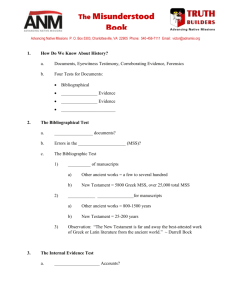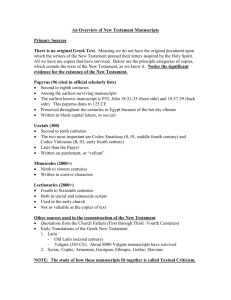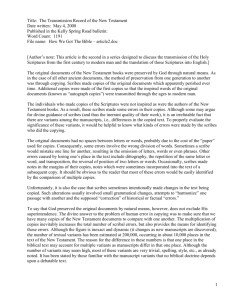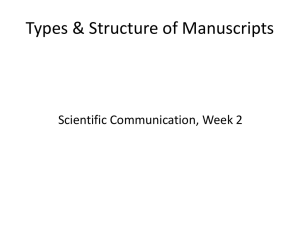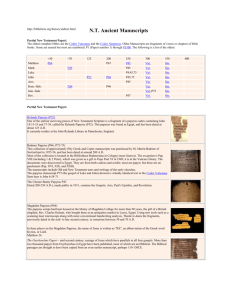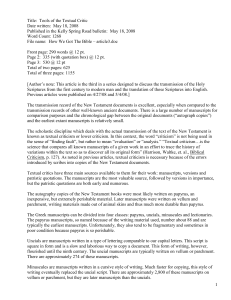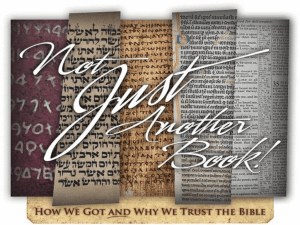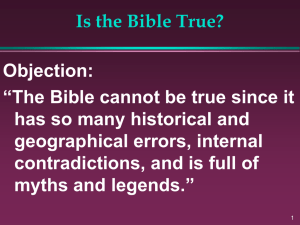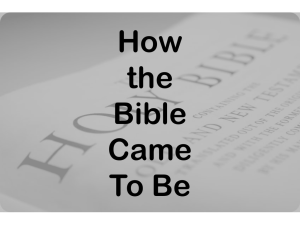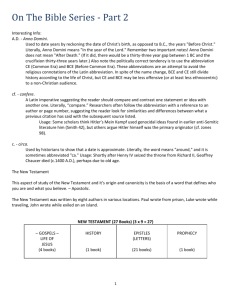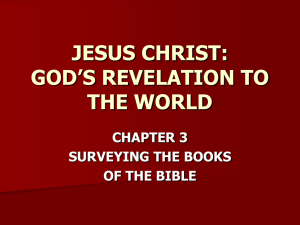Reliability of the New Testament
advertisement
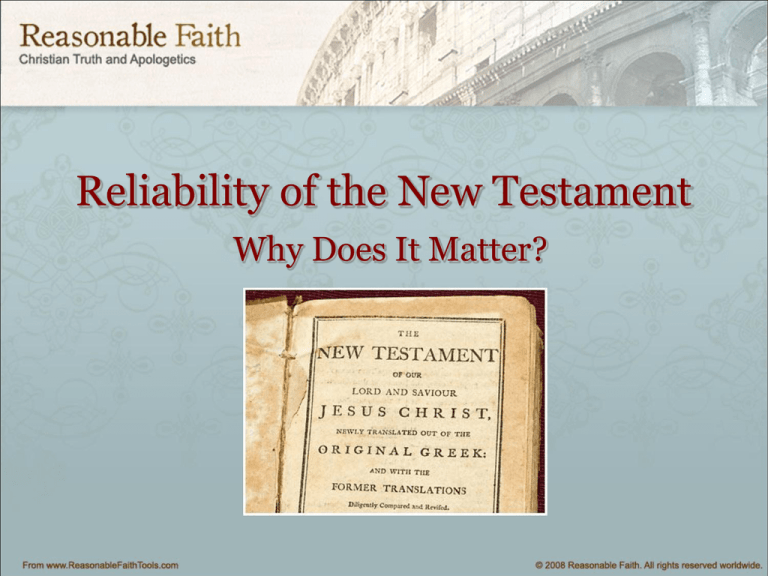
Reliability of the New Testament Why Does It Matter? F F Bruce Reliable as what? • As God’s self-revelation in Christ? • As a record of historical fact? New Testament reliability based on… • The assumption that history can be known • That the documents are reliable • That the writers were reliable In which case, we may have a problem… Objective History cannot be known because… 1. 2. 3. 4. Past events are no longer verifiable Original facts are lost – only fragments speak Historians only have records, not actual events Documents only cover a small fraction of what happened 5. Historians select which fragments they will study, so they cannot present the full story 6. Historians must recreate accounts of history, adding their own subjective interpretation to it 7. Historians present not just facts, but look to reveal meaning behind the facts 8. Imagination fills in the ‘gaps’ 9. History is thus interpreted through different worldviews 10. Thus, objective truth cannot be known No one way to interpret history So if there is more than one view on how to interpret an historical event, or document, many believe objective truth is lost to us The Truth may be out there, but we can’t know it If ‘Objective’ means absolute knowledge, then no human historian can be objective... If ‘objective’ means “a fair but revisable presentation that reasonable men and women should accept” then we have the possibility of being objective. - Geisler Ancient Manuscripts Caesar’s Gallic War has survived with 9 or 10 good copies. These copies have been dated around 900 hundred years after the events. Livy’s Roman History has survived in 20 copies from the 4th century. Tactitus’ Annals of Roman History 2 copies have survived – dating from the ninth and eleventh centuries Josephus – The Jewish War • Nine Greek manuscripts survived, copies written in tenth, eleventh and twelfth centuries • Latin translation from fourth century Homer The Iliad 643 manuscripts – 500 years after original What about the New Testament? How many New Testament manuscripts have survived? Over fourteen thousand full or partial NT manuscripts have survived • 5,686 complete or partial Greek manuscripts • 9,000 copies in Syriac, Coptic, Arabic, Latin and other languages • NT has come down to us with more manuscripts than any other ancient text All but eleven verses • 36,289 NT quotations in writings by the Early Church Fathers from 2nd to 4th century • These quotes alone capture the entire NT but for eleven verses New Testament both shortest in time and longest in manuscripts Geisler and Turek, 2004: page 226 Earliest New Testament Books? • Complete NT books were found from 200 AD • All the Gospels survive from 250 AD • No other ancient literature has such a short time span Earliest Manuscripts P 52 John Rylands papyri discovered in 1934 Found in Egypt P 52 predates P 45 by 100 to 150 years P 45 Dated from early 3rd century 200-250 Fragments of Mark, Matthew, Luke, John, Acts John Rylands papyri - P 52 • Fragment of John 18: 31-33 • John thought to be written 75- 100 • Papyri dated 117- 138 • Fragment can be dated within a generation of John’s original composition Filled with Errors? • • • • Errors do exist, but no doctrine is damaged Variants – different spelling or grammar NT documents regarded as 99.5% pure No doubt we have the Scriptures substantially as they were written – Frederick Kenyon More manuscripts lead to greater accuracy Correcting the Variants • You h#ve w*n a million d&llars • Y@u have won a m#llion doll&rs • You have won a million dollars Time between NT copies • Radical scholars place earliest gospel manuscripts at 70 to 100 AD (Jesus Seminar) • Later dates risk being too far removed from original events to have historical credibility • Allows time for legends to develop Survey of New Testament Scholarship • • • • • Matthew 65-85 AD Mark 60-75 AD Luke 65-95 AD John 75-100 AD Gospels written around 30-70 years after crucifixion – Mark Roberts Can We Trust the Gospels? Trustworthiness of Witnesses • 1 Corinthians written 55 or 56 AD • Paul speaks of over 500 witnesses – 1 Cor 15:6 • Witnesses could remember what really happened • Too soon for legends about Jesus Christ to develop New Testament Witnesses Legal-historical method • • • • Can’t verify through scientific method New Testament pattern – Eyewitnesses Still used by courts in discerning facts Peter – We did not follow cleverly devised tales “but were eyewitnesses of his majesty” – 2 Peter 1:16 Were NT writers reliable witnesses? • We are all witnesses of the fact – Acts 2:32 • We have seen it and testify to it – 1 John 1: 1-2 • We can’t help but speak of what we have seen and heard – Acts 3:15 • Paul’s 500 witnesses – 1 Corinthians 15:6 Historical Reliability? • John’s gospel - 59 details confirmed historically or as historically probable – Craig Blomberg, The Historical Reliability of John’s Gospel • Luke’s gospel – 84 accounts of historical details Classical scholar and historian, Colin Hemer Non Christian sources within 150 years of Jesus • 30 NT figures have been confirmed as historical by archaeological findings or non Christian sources • Tacitus, Suetonius, Josephus, Thallus, Pliny the Younger, Emperor Trajan, Emperor Hadrian • All affirm the existence of Jesus in sources outside the Bible Theology and History? “The evangelists wrote reliable history because they cared about what happened in the past… their theology was anchored in past events … theology leads one to care about history…believe that Jesus was really God in the flesh and you will pay close attention to what he actually did and said” - Mark Roberts To conclude: • The good news of the New Testament is bound up in both revelation and history. • “God entered in history, the eternal came into time, the kingdom of heaven invaded the realm of earth” – F F Bruce • “To reject the historicity of the New Testament is to reject all history” – Norman Geisler
